I’ve very excited to see that my poem ‘A very Funny Animal is poem of the day on the Australian Children’s Poetry website today! Yay!



I’ve very excited to see that my poem ‘A very Funny Animal is poem of the day on the Australian Children’s Poetry website today! Yay!


This week at the Carrot Ranch, Charli Mills challenged writers to In 99 words (no more, no less), write a story about a beaver slap. It can be an actual tail slap warning on the water or an imitation. Is a beaver slap the name of something — a new type of burger, perfume, or a sci-fi gadget? Take ecological and poetic licenses. Go where the prompt leads!
We don’t have beavers in Australia and I’d neither heard, nor heard of, a beaver slap before. However, we do have:
A Very Funny Animal
It isn’t quite a beaver, though it has a beaver’s tail,
A freshwater-living mammal, much smaller than a whale.
It’s something like an otter with body dressed in fur.
Its bill and feet are duck-like but it has a poisonous spur.
It burrows into riverbanks to lay its eggs therein.
It swims around in waters while having not one fin.
If you come across it, I urge you not to scream.
It wouldn’t ever harm you. It’s just a monotreme.
Its name can be quite tricky, but you’ll learn it without fuss.
So try:
Or –
Or – nith – or
Ornithorhynchus.
(Apologies to C.J. Dennis for this poem poorly modelled on his wonderful Triantiwontigongolope which you can read in full here.)
You might know this creature better as the platypus.
The poem, although it is 99 words, isn’t really my response to the prompt. It began more as an explanation of my response which follows.
When Europeans first arrived in Australia, they had never seen anything like the platypus, which is an egg-laying mammal, or monotreme. The first scientists who studied the platypus, thought it was a fake, made up of the body parts of several animals. I hope I’ve captured its uniqueness in both my poem and my story.
You may enjoy this video about the platypus. My story Impossible Creature follows it.
By the way, we have neither otters nor beavers in Australia.
Impossible Creature
The day was magic with the sunlight and laughter of summer holidays.
They were resting on the riverbank when a splash broke the spell. “What was that?”
“A fish? Must’ve been big.”
“It was a duck! I saw its beak before it dived.”
“That’s ridiculous. It’s an otter. Ducks don’t have fur.”
“Can’t be an otter. Their tails aren’t flat. Gotta be a beaver.”
“Duh! There’s no beavers in Australia.”
The surface broke again.
“Look! Webbed feet. It is a duck. I told you.”
“But not with that spur.”
“A furry duck with spurs. Someone’s playing tricks. But who?”

Thank you for reading. I appreciate your feedback. Please share your thoughts.

Note: The collection of stories made in response to the previous prompt Two Can Keep a Secret, including mine, can be read at the Carrot Ranch.

Quoll’s Great Idea is about a Spotted Quoll who has very cold feet in the snow and finds a novel way to overcome this.
Today it is my pleasure to share my review of Quoll’s Great Idea written by Joanna Tait and illustrated by Muza Ulasowski. Muza sent me a copy of the book in return for an honest review.
I have always admired Muza’s beautiful artwork and have previously introduced her to you when interviewing her about the beautiful picture book Forest Wonder written by Caroline Tuohey. You can read that interview here.

Joanna Tait is a medical practitioner, mother of five and grandmother of five with more grandchildren on the way. She has been writing all her life. Quoll’s Great Idea is her first published children’s picture book, with several more currently being illustrated.

Quoll’s Great Idea by Joanna Tait and Muza Ulasowski is a great read allow introducing
Muza Ulasowski established her art studio, Muza Designs, in 2007, set in the leafy western suburb of Brookfield in Brisbane, Queensland, Australia. The studio is surrounded by a vast array of wildlife who tend to regularly make an appearance in her illustrations.
In 2010, she was invited to illustrate her first children’s picture book and enjoyed it so much, she has been collaborating ever since with Australian and international authors and publishers. To date she has illustrated over 10 published children’s picture books and is currently illustrating several more.
Whilst primarily concentrating on creating digital images for children’s picture books, Muza also specializes in graphic design, designing book covers and book layouts to print ready stage.
She also enjoys creating pencil and charcoal illustrations, acrylic painting, photographing wildlife and creating colourful merchandise from her artwork on her trusty sewing machine.
About Quoll’s Great Idea — the blurb
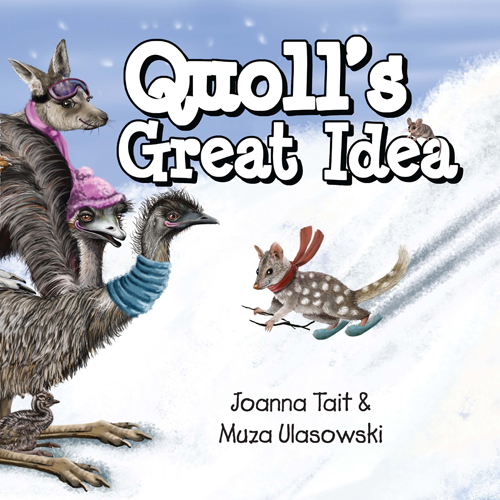
Continue reading: Quoll’s Great Idea by Joanna Tait and Muza Ulasowski — a review – readilearn

This month, it is my pleasure to introduce you to award-winning Australian author Aleesah Darlison. Aleesah writes picture books, chapter books and novels. Her much-loved stories promote courage, understanding, anti-bullying, self-belief, teamwork and environmental themes. In 2015, she won the Environment Award for Children’s Literature (Non-Fiction) for her picture book, Our Class Tiger. She has won numerous other awards for her writing.
Aleesah has written over thirty-five books for children and in 2016, she set up Greenleaf Press, a business designed to provide critical support services to authors and illustrators. The company also acts as a booking agency for school and preschool visits.
Today, Aleesah and I are talking about her picture book Stripes in the Forest. With National Threatened Species Day just a couple of weeks away on 7 September, it is a timely interview. Stripes in the Forest is the story of an iconic species lost.
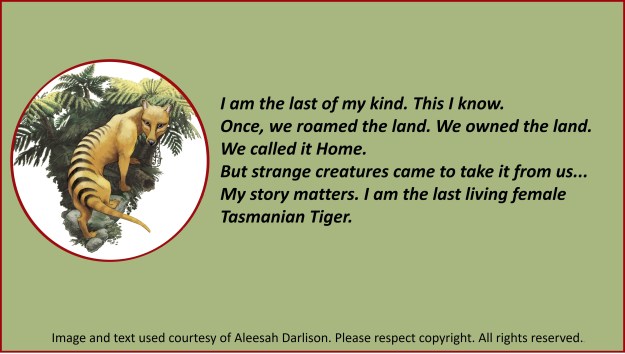
Told from the perspective of the last wild female thylacine, it provides readers with an insight into the rare beauty and uniqueness of these amazing animals, explains their fight for survival and provides important lessons for future generations.
An emotive and moving story, children will connect with the solitary, stoic and courageous female thylacine who does all she can to protect her young – just as a human mother would do. The story takes readers to a place in the past, but also offers a twist that projects them
Continue reading: Meet Australian picture book author Aleesah Darlison – Readilearn
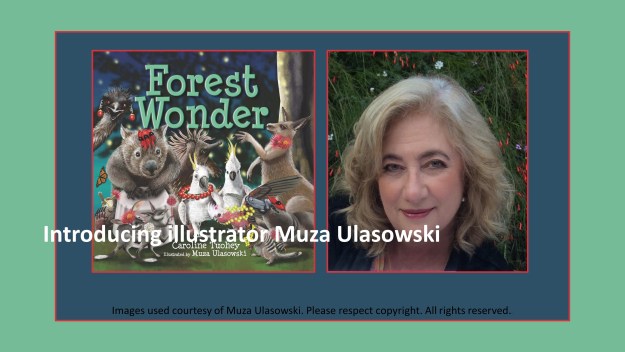
This month I am delighted to introduce you to the very talented illustrator Muza Ulasowski. I’m certain you will find her illustrations to be quite remarkable.
Although Muza has illustrated many books, I first came across her work in the beautiful picture book Forest Wonder, written by Caroline Tuohey. It is Forest Wonder, a winner of international awards, that Muza and I are discussing today. Before we get started on the interview, first let me tell you a little about Muza.
Muza Ulasowski is a graphic designer and children’s book illustrator based in the leafy western suburb of Brookfield in Brisbane, Queensland. Australia. She is inspired and surrounded by a vast array of local birds and animals who tend to make their appearances in her book illustrations. She shares her life with her wonderfully patient husband, their charismatic bulldog called Charlie and a black magic cat named Basil.
In 2010, she was invited to illustrate her first children’s picture book and enjoyed it so much, that
Continue reading: Introducing illustrator Muza Ulasowski – Readilearn
This week at the Carrot Ranch, Charli Mills is talking about getting cozy. While we swelter in the heat of our Australian summer, getting cosy is the last thing we are thinking of. Keeping cool is our current priority. (Note: cozy in North America, is cosy in Australia!)
When I think of cosy, I think of huddling in front of a fireplace, shawl over my knees, cat at my feet, and a glass of wine, perhaps Prosecco, in my hand. This is not something I have ever experienced. It is an image portrayed on Christmas cards, book covers, and in movies.
It’s a bit of a stretch for me to contemplate cosy at the moment, and I wondered how young Australians with little experience of “cosy” might respond to the word.
I asked 7-year-old grandson what he thought of when he heard the word “cosy”. He said,
“Nice and warm in bed.”
His Dad thought there could be no better definition. In fact this is the definition provided by Google:

I asked grandson if he thought we would want to be cosy in summer and he said, “Well maybe not warm, but snuggly.” I think he did pretty well in defining the word.
Snuggly makes me think of the children in bed as shown in Helen Magisson’s version of The Night Before Christmas. (Look for the interview with Helene on the readilearn blog later this month.)
No doubt you have heard the expression, “snug as a bug in a rug”. Like cosy, the expression refers to being in a pretty comfortable position. I figured that being in a pouch would be about as cosy as a creature could get and, since Australia is home to many marsupials, it seemed a perfect fit for the post.
Marsupials are mammals that give birth to live young before they are fully developed. The young, usually referred to as joeys, continue to develop in the mother’s pouch for a number of months, suckling on their mother’s milk.
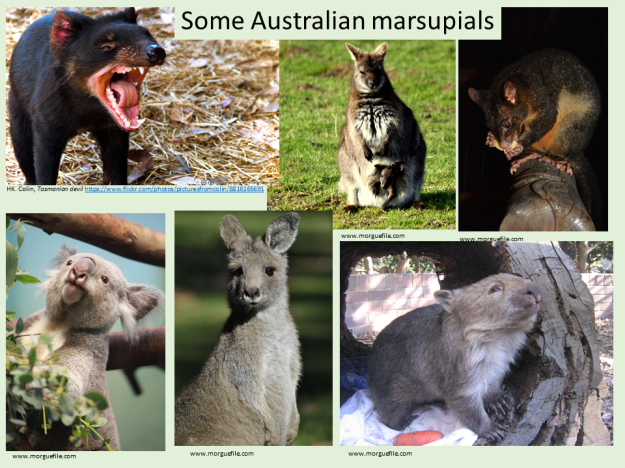
As explained in Feeling a little prickly, Australia is home to almost 70% of the world’s marsupials. Other marsupials are found in the Americas, mostly South America. Kangaroos, wallabies, koalas, possums, wombats, Tasmanian devils, numbats, bilbies, and quolls are among the species of marsupials found in Australia.
Brushtail possums are common in Australia and frequently share our homes as well as our neighbourhoods.
At the moment, a mother and baby have taken up residence in Hub’s carport/workshop. We’re not particularly happy when they share our homes, but I love to hear and see them in the garden. Although I must admit that hearing a male brushtail possum for the first time can be a disturbing experience. I wrote about this in Sounds like …
While possums are not popular in New Zealand and efforts are being made to eradicate them, and other introduced pests, from the island nation; I think they are rather cute. When I was young I climbed everywhere and got into everything and, as a result, was nicknamed “Possum”. (What happened to that inquisitive child?)
I have previously written about some of my favourite picture books about possums, including Possum in the House and Possum Goes to School in Listen to the sounds, and Possum Magic by Mem Fox in A celebration of Australian picture books #2 – Mem Fox
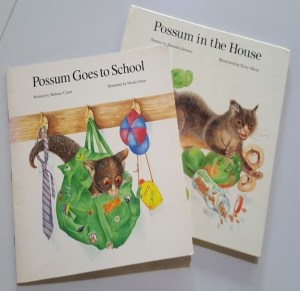

When Charli Mills of the Carrot Ranch challenged writers to In 99 words (no more, no less) write a cozy story, how could I not write about a cute little possum joey getting cosy in the mother’s pouch. I hope you like it.
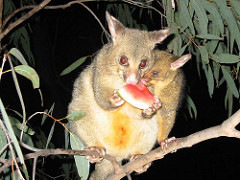
Watermelon by Peter Firminger https://www.flickr.com/photos/wollombi/251246865
Happy as a possum in a pouch
Warm and cosy in mother’s pouch, for months he did no more than suckle and sleep. Lulled by her gentle heartbeat and rhythmic breathing, he barely noticed as she scurried about at night; foraging for food, leaping from branch to branch, avoiding neighbourhood cats, sometimes scouring dogs’ bowls for leftovers, or accepting humans’ sweet titbits. For him, nothing else existed. Until … one night, a strange feeling stirred inside. He poked his whiskery nose outside. Sniff, sniff. The most delicious scent beckoned him out. Mother offered him something red. Zing! His senses ignited. Milk was forgotten, nightly foraging began.

Thank you for reading. I appreciate your feedback. Please share your thoughts.
Australia is home to a great diversity of, and many unique animals. Most native Australians are not found anywhere beyond its territories. I guess that’s not surprising since it is the world largest island or smallest continent country with vast expanses of ocean between it and other continents.

Australia is home to almost 70% of the world’s marsupials. Other marsupials are found in the Americas, mostly South America. Kangaroos, wallabies, koalas, possums, wombats, Tasmanian devils, numbats, bilbies, and quolls are among the species of marsupials found in Australia.
Marsupials are mammals that give birth to live young before they are fully developed. The young, usually referred to as joeys, continue to develop in the mother’s pouch for a number of months, suckling on their mother’s milk.
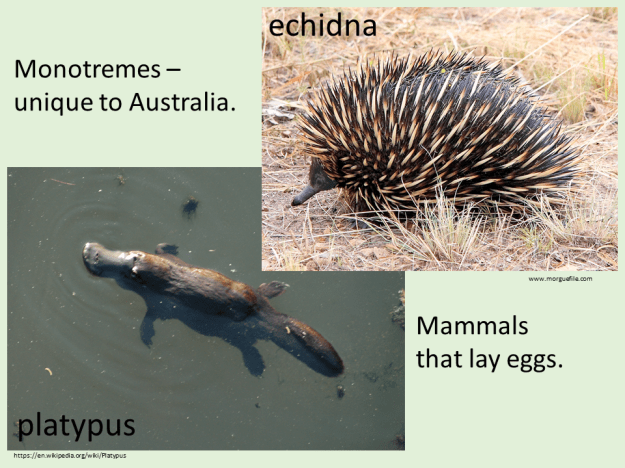
There is another group of even more unusual mammals: the monotremes. Monotremes are egg-laying mammals. The platypus and the echidna, the only existing species of monotremes, are unique to Australia.
The platypus
When Europeans first saw a platypus, they thought it was a hoax with its bill like a duck’s, tail like a beaver’s, and feet like an otter’s. It has fur like other mammals but, unlike other mammals, it lays eggs.
The platypus lives in burrows on the banks of freshwater streams and small rivers in eastern Australia, including Tasmania. It spends much of its time foraging in the muddy river beds for crayfish, worms and insect larvae.
Female platypus usually lay two eggs. When the young hatch, the mother releases milk from pores in her skin. The milk pools on her abdomen and is lapped up by the young for about three to four months. There is no special baby name for baby platypus. They are simply called ‘baby platypus’.
The male platypus, with a poisonous spur on its hind foot, is one of only a few venomous mammals.
Platypus predators include crocodiles, eagles, dingoes, and introduced animals such as foxes and feral cats.
The echidna
Echidnas, the oldest surviving mammals, live all over Australia in many different habitats. They usually live alone and are not territorial. Although it is rare to see an echidna in the wild, they are considered common. They generally hide away under vegetation, in logs, or in the burrows of other animals.
Echidnas eat termites and ants, and sometimes the larvae of other insects. They use their long snouts to forage in leaf litter, rotting logs, or ant mounds in search of food. Their long tongues are covered in sticky saliva for catching prey.
Echidnas are covered with spines along the head, back and tail. The spines are sharp and used for defence against predators.
Female echidnas usually lay one egg at a time. When the young, called a “puggle”, hatches, it makes its way to the mother’s pouch area to suckle milk. When the puggle starts to develop spines, at about 50 days, it is removed from the pouch. The mother continues to suckle it until it is about six to seven months old, at which time she deposits it at the entrance to the burrow, then walks away and abandons it.
Predators include goannas, Tasmanian devils, dingoes, eagles, and introduced animals such as foxes and feral cats. When threatened an echidna may run away or curl up in a ball.
Although all have spines, echidnas are not related to either hedgehogs or porcupines.
Here is a great article about these amazing echidnas.
If you are looking for books about Australian animals, check out the Steve Parish Storybook Collection by Rebecca Johnson, featured in last month’s Author Spotlight, which includes stories about both monotremes, many marsupials, and other fabulous creatures.
Monotremes and marsupials feature in the readilearn stories Bullfrog’s Billabong and Little Koala’s Party and their suite of resources.
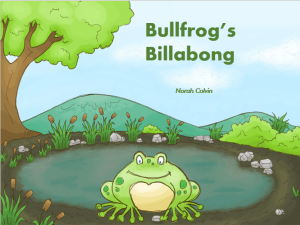
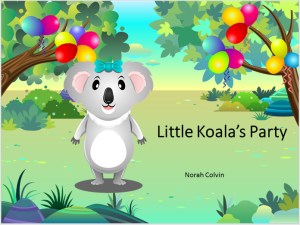
I was prompted to think about the diversity and uniqueness of these Australian animals, especially the echidna, by this week’s flash fiction challenge set by Charli Mills at Carrot Ranch Communications. She challenged writers to In 99 words (no more, no less) write a prickly story. I thought there was no better opportunity to share with you some of our amazing creatures, particularly since just last week I was lucky enough to see an echidna in the wild for the very first time.
The uniqueness and diversity of Australian animals reflects our own individual uniqueness and the diversity among us. We have much to learn about accepting difference, appreciating diversity, and acknowledging the unique characteristics each individual contributes to the enrichment of our collective humanity. Together we stand. Divided we fall.
Here is my response. I hope you enjoy it.
Stronger together
She bristled, warning platypus to stop. He didn’t.
“Feeling a little prickly, are we?”
Kookaburra, oblivious, laughed at the “joke”.
She smarted. Couldn’t he see the hurt in his words? Like a spur in her side, that last barb, really stung. Mocking difference pushed them apart.
The bush quietened. Not a breath of wind. Not a leaf’s rustle. Not a bird’s chirrup. Were all waiting for the victor to be decided?
Suddenly, out of the undergrowth, rushed a devil, hungry for blood.
Platypus turned to echidna. She contemplated leaving him. But stayed. Spur and spines together: a powerful defence.
Author’s note: Tasmanian devils have been known to eat echidnas, spines and all!

Thank you for reading. I appreciate your feedback. Please share your thoughts.